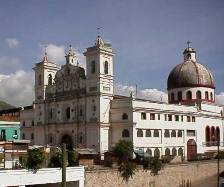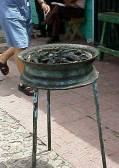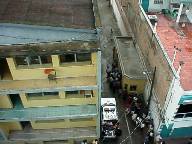

Tegucigalpa, Honduras
La Iglesia de los Dolores
September 1999
Tegucigalpa is the Nahutal word for "Silver Hill". The city dates from 1578,
when silver was discovered along the banks of the Choulateca River.
Arrival in Tegucigalpa, Honduras was on Thursday, September 3rd. We caught a cab to our hotel in the downtown area. We stayed in the city for a few days before travelling into the Central Highlands to the city of Siguatepeque. The three of us stayed at the Hotel MacArthur on 8 Calle (Avenida Lempira) between 4/5 Avenida. The hotel was pleasant and clean - terrazzo floors, mahogany cabinets. We had two beds plus a sleeper sofa, air conditioning, and cable TV. Laundry service is available for a small fee. The current room rate (September 1999) is $44/night for three people. The hotel also has a cafeteria/coffee shop and about 100 yards from the hotel entrance is a neighborhood panaderia (bakery). The neighborhood we stayed in was a mixed residential and commercial area that also contained several schools. |
 |

|
| La Iglesia de los Dolores. Construction on the church was started in 1732. The gold plated altars provide evidence of the importance of mineral wealth in Tegucigalpa during the previous centuries. In front of the church is a large plaza, peatonal (pedestrian mall), and street vendors. Everything from fresh food (fruits, vegetables, and quick meals) to clothing and luggage is available. In addition to the street vendors there are regular shops along the peonatal that sell clothing, appliances, textiles and furniture. The aromas emanating from the vendors are enough to make your mouth water: warm corn tortillas, frying plátanos (plantains), grilled and fried pollo (chicken), field ripened pineapples and melons. Corn grows in the small gardens in the plaza and you literally can watch it grow. Each day it was several inches taller than the day before. In the afternoons you will find any number of young boys engaged in a game of marbles by the fountain in the plaza. Occasionally the marbles game is replaced by an impromtu game of futbol (soccer). The plaza is also a feast for the eyes and ears: the brilliant colors of the fruits and vegetables, the flowers in the plaza gardens, the terra cotta colors of the plaza bricks, the sounds of the vendors hawking their wares, the sounds of the children at play, the sounds of pealing church bells and a congregation at prayer. |
The local vendors are ingenious in their use of materials. Recycling of materials takes on a whole new meaning here in Tegucigalpa. What can you do with an old wheel from a motor vehicle? Why use it as the base for a barbecue grill of course! This wheel reincarnated as a grill was spotted on the plaza near the church. Several smaller hotels and boarding houses are also in this area. One important and useful place is a small mercado (shop) on the corner behind the church - 5 Avenida at 7 Calle. The Hong Kong born owner of Mercado San is trilingual (Chinese, English, and Spanish). He is quite helpful with directions and the shop is a source of soft drinks, personal items, snacks, etc. |
 |

|  |
Upon our return from Siguatepeque, we stayed at the Hotel Istmania on 5 Avenida, across from the police station and civil court. The hotel provides airconditioned rooms, cable TV, and a dining room with bar. Some rooms have balconies facing the Avenida. A plus is that both the day and night managers are bilingual (Spanish, English). If cable TV gets boring, there is always people watching on the Avenida. The passing tide of humanity includes nuns on the way to church, middle class office workers walking to work, delivery people on motorcycles zipping around town, the stream of people waiting to go to court, and the police station activity. Independence Day proved interesting at the Hotel Istmania. Cable TV had been knocked out by a severe thunderstorm the night before so we watched life go by outside our hotel. Independence Day means a busy day for the police. September 15, 1999 certainly was no exception as this photo illustrates. The yellow building is the court and police duty rooms, the alley leads to the city jail. The vehicle in the alley is a quad cab pickup truck with two policemen in the cab and two in the bed of the truck with about 10 or so "detainees" that were hauled in for various crimes (like drunk and disorderly). The crowd at the control booth to the right is waiting to bail out people. |
| Photo & Vacation Index | Plaza Morazan | El Picacho | Photos |
